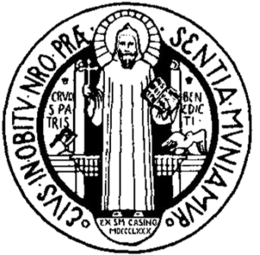Stanbrook Abbey
With the steep contemporary decline in monastic life, the community left their Grade II-listed property,[2] to relocate to Wass in the North York Moors National Park in 2009.The project was initiated in 1621 by an English Benedictine (EBC) monk called Benet Jones, who had been in contact with several interested young women in England while on mission duties there.[3] The nine original members were escorted by him from England to Cambrai (which the English then called Camerick),[4] where they took over the ruined town-house of the defunct Benedictine abbey of Saint-Étienne-de-Fémy, restored it and moved in at the end of 1623.[5] The most notable among the foundresses was 17-year-old Helen More, professed as Dame Gertrude More, who was the great-great-granddaughter of St Thomas More; her father, Cresacre More, provided the original endowment for the foundation of the convent.One unusual source of income was from fine paperwork, which involved cutting sheets of paper into complicated patterns and figurative depictions for decorative purposes.They were taken to Compiègne and imprisoned there for eighteen months in the former Convent of the Visitation, during which time four of them died from the harsh conditions which included inadequate food and an outbreak of typhus.After petitioning to be allowed to go into exile in England, the seventeen survivors were released in April 1795 and put on a boat at Calais, which took them to Dover where they arrived destitute on 2 May.They had to depend on donations to survive, but the government granted the nuns a pension of one and a half guineas (£1.575) per month, which gave the community an annual income of £302.40[18] (or £36,617 in 2020 values).[2] The nuns' chapel is significant in the architectural history of the period owing to its neo-classical style and the role of Baroque design influences on its interior.[29] The original entrance to the new abbey precinct was to the south, on Upton Road, where a pair of semi-octagonal gate lodges survive and are Grade-II listed.He helped the nuns become noted practitioners of Gregorian chant, through the influence of the liturgical tradition being revived by Prosper Guéranger at Solesmes Abbey in France.When the designs of Edward Welby Pugin, in Gothic Revival style, proved too expensive, Shepherd insisted on changes including a traditional tall church tower with a clock and a ceiling vault for acoustic reasons.[38] In 1923, the nuns commissioned the furniture maker Robert "Mouseman" Thompson to fit out their refectory including tables, chairs, wall panelling with his signature carved mouse.[38] The height of Edward Pugin's grand Gothic high altar obscured the great rose window at the church's east end which contained stained glass in honour of the Virgin Mary.[43] Further reconstruction occurred when the church sanctuary was re-ordered in 1971 by Anthony Thompson, with the loss of the original Pugin fittings including the cut-down high altar, the surviving wall paintings, and the Minton encaustic floor tiles for a plainer style.[44] The wrought iron rood screen was donated to Birmingham Art Gallery, and the altar in the extern chapel (dedicated to the Sacred Heart) was also removed.That year marked the death, at 95, of Dame Werburg Welch, an artist whose work in a range of media can be found across the country; she was also an arboriculturist, taking care of the orchard at Stanbrook.[54] This led to controversy about priorities as shown in a letter to The Times newspaper, on 23 January 2006: The present Abbess’s determination to sell up Stanbrook Abbey and build an inadequate bijou hideaway on the Yorkshire moors, in a National Park of all places, despite the wishes of some in her community, comes at the fag-end of the 1960s cult of ultramodernity in religion.This contempt for history and tradition will pass with the generation that created it, though it has done immense harm to the English Catholic Church and looks likely to consign the Stanbrook community to extinction.[55]Three sisters, including, Catherine Wybourne, also known as 'Digitalnun') left the community, and in September 2004 founded Holy Trinity Monastery at East Hendred in Oxfordshire.It involved shifting a 40,000 volume library of books and archives from Stanbrook, which was overseen by the theologian and former hermit, Mary Boulding, near the end of her life.[11] Previous superiors include (in alphabetical order of surname): The first Roman Catholic archbishop of Sydney in Australia, John Bede Polding, had been taught by the nuns as a little boy.In 1849, he appealed to the abbey to provide nuns for a monastery that he was founding at Rydalmere, New South Wales, to be called Subiaco after the Italian location where St Benedict had begun monastic life.[69] In 1907, a group of young women from São Paulo in Brazil entered the noviciate in order to become the founding community of the Abadia di Santa Maria in their city.One of the Brazilian daughter houses, Abadia de Nossa Senhora das Graças in Belo Horizonte, has itself given rise to four further foundations in Brazil.The new owners erected an imposing entrance gateway west of the original one, laid out car parks and converted the nuns' cells, with no plumbing, into en-suite bedrooms.A large marquee-style hall to serve as an events venue was attached to the Old House, and both of these additions were deliberately done in a contemporary style in contrast to the original buildings.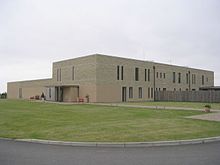


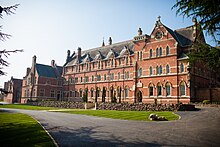



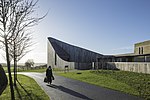

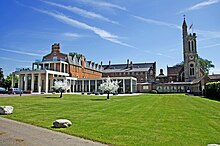
Wass, North YorkshireHelen MoreCambraiCatholic religious orderCatholic ChurchSaint BenedictCatholiccontemplativeBenedictineMonasteryEnglandFlandersSpanish NetherlandsFranceEnglish Benedictine CongregationFrench RevolutionCallow EndWorcestershireNorth York MoorsGertrude MoreCatherine GascoigneOur Lady of ConsolationEnglish BenedictinenoviciateEnglish monastery at BrusselsprofessedThomas MorehonorificDames Commander of the Order of the British Empireabbots and abbessesAugustine BakerDivine Officemonastic enclosureabbotsColwich AbbeyCompiègneConvent of the VisitationtyphusMartyrs of Compiègnesecond-class relicsWooltonreligious habitsumptuary lawbreach of the peaceguineasJohn Bede PoldingDownside AbbeyRoman Catholic archbishop of SydneyAbbot's Salfordrecusantpriest holeincorruptlisted buildingLittle MalvernPowickSevernMalvern, WorcestershirealdermanWorcesterpresbyterycounty surveyorneo-classical styleBaroquegate lodgesGregorian chantProsper GuérangerSolesmes AbbeycloisterHildebrand de HemptinneBeuron ArchabbeyAugustus Welby PuginRamsgateGothic Revivalcatacombvirgin martyrcloister rangesPeter Paul PuginCuthbert Welby PuginGeorge Ashlinpilgrimagecrown of thornsGlastonbury AbbeyGlastonbury Thornsacristypapal enclosureHazel HastingsRobert "Mouseman" Thompsonrefectorythe Virgin MaryGeoffrey WebbmonstrancePhilip Lindsey ClarkstencillingHistoric EnglandMintonencaustic floor tileswrought ironrood screenBirmingham Art GallerySacred Heartprivate pressHildelith CummingFelicitas CorriganBoston CollegeletterpressWerburg WelcharboriculturistMeinrad CraigheadTeresa of AvilaSiegfried SassoonSecond Vatican CouncilPostulantsCatherine WybourneHoly Trinity MonasteryEast HendredOxfordshireMary BouldingFeilden Clegg Bradley StudiosRIBA National AwardRyde AbbeyBarbara ConstableLaurentia McLachlanSydneyAustraliaRydalmere, New South WalesSubiaco
